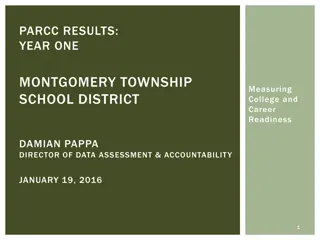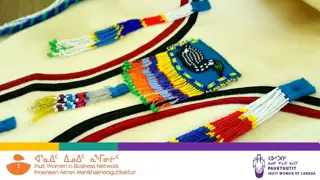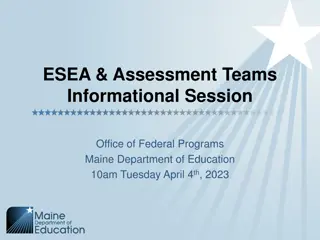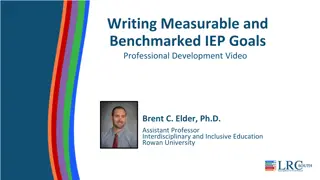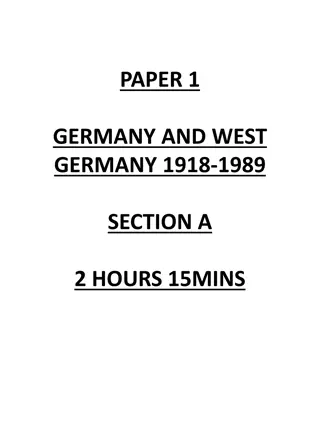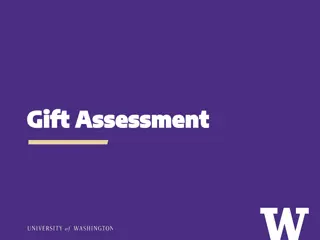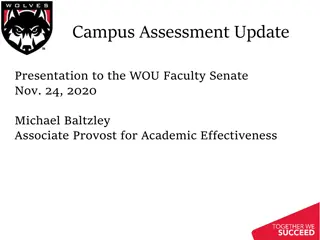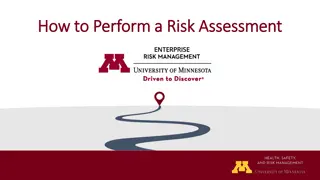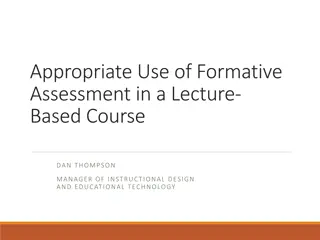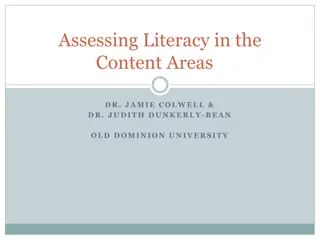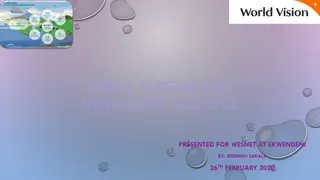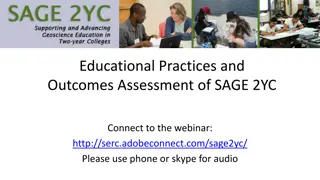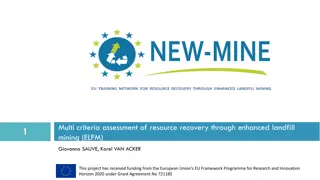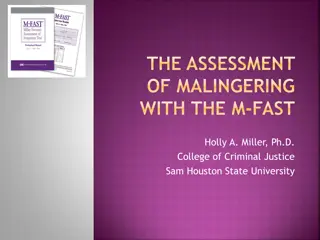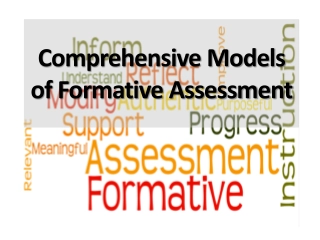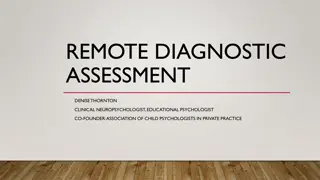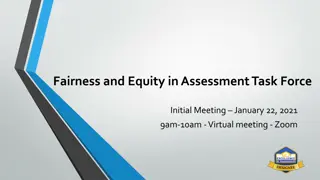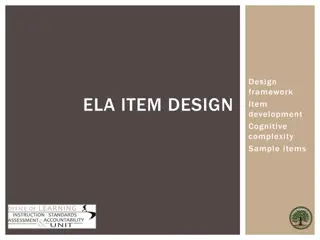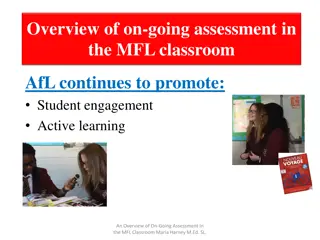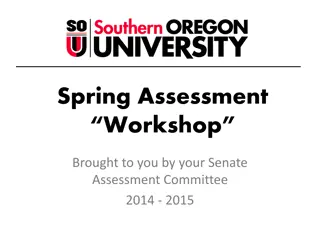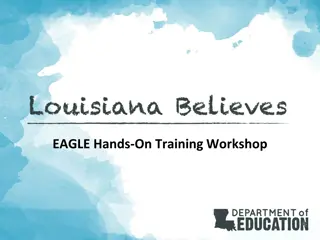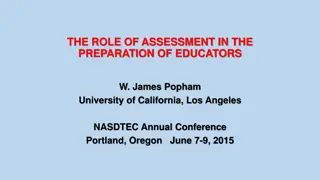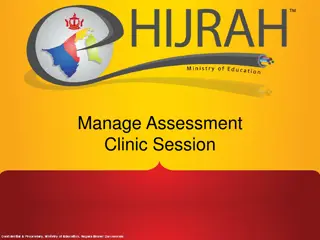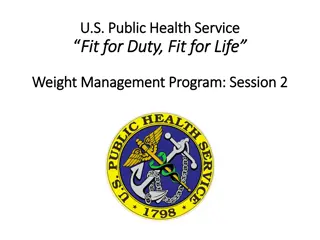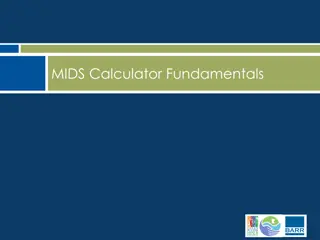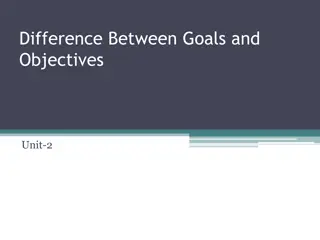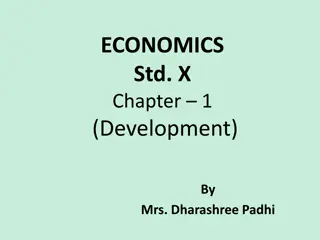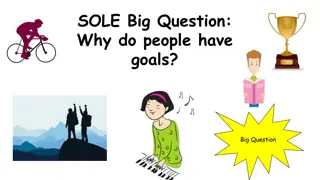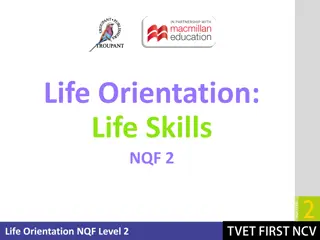Understanding PARCC Assessment Structure and Goals
Explore the PARCC assessment structure, performance tasks, unit assessments, and goals for teachers and students in ELA. Discover innovative item types showcasing students' command of evidence with complex texts. Engage in activities like jigsaw learning to enhance understanding.
Download Presentation

Please find below an Image/Link to download the presentation.
The content on the website is provided AS IS for your information and personal use only. It may not be sold, licensed, or shared on other websites without obtaining consent from the author. Download presentation by click this link. If you encounter any issues during the download, it is possible that the publisher has removed the file from their server.
E N D
Presentation Transcript
Taking a Look at PARCC Deb Bellinger Elementary Curriculum Consultant Calcasieu Parish
Goals Teachers will be able to describe the structure of the PARCC assessment, including the three performance tasks and the item types. Teachers will be able to describe the three unit assessments and how they will prepare students for the PARCC assessment.
Goals for Students in ELA Comprehend (access) meaningful, on level texts Speak and write in response to meaningful texts
Agenda PARCC Performance Assessment Tasks Item Types and Structure of the Assessment Unit Assessments in the Guidebook
3 Performance Tasks Literary Analysis Narrative Research Simulation
Jigsaw Form a group of three Number yourselves 1-3 PARCC Performance Based Component 1s read Literary Analysis 2s read Narrative Writing 3s read Research Simulation Choose 3 key points to share with your team I will signal when to begin (1 min each)
Agenda PARCC Performance Assessment Tasks Item Types and Structure of the Assessment Unit Assessments in the Guidebook
Performance Based Assessment Item Types
Three Innovative Item Types That Showcase Students Command of Evidence with Complex Texts Evidence-Based Selected Response (EBSR) Combines a traditional selected-response question with a second selected-response question that asks students to show evidence from the text that supports the answer they provided to the first question. Underscores the importance of Reading Anchor Standard 1 for implementation of the CCSS. Technology-Enhanced Constructed Response (TECR) Uses technology to capture student comprehension of texts in authentic ways that have been difficult to score by machine for large scale assessments (e.g., drag and drop, cut and paste, shade text, move items to show relationships). Range of Prose Constructed Responses (PCR) Elicits evidence that students have understood a text or texts they have read and can communicate that understanding well both in terms of written expression and knowledge of language and conventions. There are four of these items of varying types on each annual performance-based assessment. 11
Try It Read the text Life in the Limbs by Heather Kaufman-Peters Answer the EBSR and TECR items. Discuss your answers at your table.
Evidence Based Selected Response Part A: What is the purpose of the braces described in paragraph 6 of the article? a. They fix broken tree limbs, so a tree house will not fall down. b. They lock several trees together, so almost any kind of tree can be used. c. They join two trees into one unit, so a tree house looks secure. d. They help trees hold up a tree house, so the trees will not break.* Part B: Which two details from the article help support the answer to Part A? a. Designing unique tree houses may sound tough, but Jonathan says it's no sweat. b. Hardwoods such as oak, maple, or hickory make the best trees for houses but I did once build a wonderful tree house in a crabapple tree. c. My tree house is in two trees an oak and a fir and has three posts to support the weight. * d. As a certified arborist, Jonathan tries to never harm the trees. * e. "The tree's center of gravity is at the top and the ends of its branches, so I build a house down at the center of the tree. . . f. "The tree grows over the artificial limbs, and they become part of the tree, . . .
Technology Enhanced Constructed Response Possible Main Ideas Possible Supporting Details Choose the two main ideas and drag them to the empty box labeled Main Ideas. Then choose one detail that best supports each main idea. Drag each detail into the empty box labeled Supporting Details. Jonathan has his own 1000- yard zipline. "In fact, as a tree house architect, Jonathan has built more than 380 custom tree houses across the United States."* Jonathan is an experienced tree house builder.* Jonathan s love of tree- house living began when he was a kid. Jonathan works carefully so that tree houses do not hurt the trees.* "It was the most fun I ever had." Main Ideas Supporting Details Jonathan lived in a tree house when he was in college. "'I build a tree house so it helps the tree,' he says."* Jonathan advises readers to learn the names of trees. "'Walk in the woods and learn the different trees. Spend time climbing and learn how to do it safely.'" Jonathan once built a house in a crab apple tree. One of his favorite names is Ups and Downs.
Item Types Evidence Based Constructed Response Technology Enhanced Constructed Response Prose Constructed Response
Performance Based Assessment Structure of the Tasks
Literary Analysis How is this different from the way our students have been assessed? Read 1 extended literature text Respond to 1 vocab question Respond to 2 EBSR or TECR Read 1 additional literature text Respond to 1 vocab question Respond to 2 EBSR or TECR Respond to 1 PCR - essay
Research Simulation Session 1 Read 1 anchor text Respond to 1 vocab question Respond to 2 EBSR or TECR Session 2 Read additional text (may be multi-media with transcript) Respond to 1 vocab question Respond to 2 EBSR or TECR Read additional text (may be multi-media with transcript) Respond to 1 vocab question Respond to 2 EBSR or TECR Write a PCR - information Grade 3 will have only 2 texts
Narrative Task Read 1 short text (either literary or information) Respond to 5 EBSR or TECR Respond to 1 PCR - essay
Agenda PARCC Performance Assessment Tasks Item Types and Structure of the Assessment Unit Assessments in the Guidebook
Each Unit Will Have 3 Assessments Culminating Writing Task Cold Read Assessment Extension Task
Work with a neighbor to answer: For which task(s) will this assessment prepare students? How will this task address the goals for students?
Goals for Students in ELA Comprehend (access) meaningful, on level texts Speak and write in response to meaningful texts
Goals Teachers will be able to describe the structure of the PARCC assessment, including the three performance tasks and the item types. Teachers will be able to describe the three unit assessments and how they will prepare students for the PARCC assessment.
Feedback Deb Bellinger deborah.bellinger @cpsb.org


